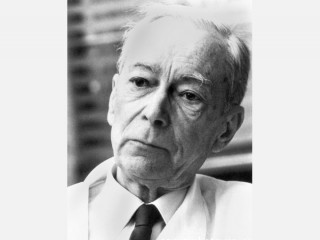
Henrik Dam biography
Date of birth : 1895-02-21
Date of death : 1976-04-17
Birthplace : Copenhagen, Denmark
Nationality : Danish
Category : Famous Figures
Last modified : 2011-01-27
Credited as : Biochemist, Nobel Prize in Physiology/Medicine,
The Danish biochemist Carl Peter Henrik Dam shared the Nobel Prize in Physiology/Medicine for his discovery of vitamin K.
Henrik Dam, the son of Emil Dam, an apothecary, was born in Copenhagen on Feb. 21, 1895. He graduated in chemistry at the Polytechnic Institute, Copenhagen, in 1920 and then held two instructor's posts in chemistry and biochemistry. In 1928 he was appointed assistant professor of biochemistry in the University of Copenhagen. In 1929 he was appointed associate professor, and in 1941 professor. In 1934 he graduated as a doctor of science of that university. While holding a Rockefeller Fellowship he worked at Freiburg (1932-1933) and at Zurich (1935).
In 1928 Dam started to work on the cholesterol metabolism of chicks. He fed them a practically sterol-free artificial diet to which vitamins A and D had been added. He proved that, contrary to the current view, chicks could synthesize cholesterol. But he also found that some chicks developed internal hemorrhages and delayed blood coagulation. In 1932 scientists in California claimed that this disease was due to the absence of vitamin C from the diet, but Dam showed that it was not cured by the addition of ascorbic acid (that is, pure vitamin C) to the diet. He also demonstrated that a diet rich in cereals and seeds prevented the disease, and in 1934 he announced that it was due to the absence from the diet of a hitherto unrecognized factor. He then found this factor to be fat-soluble, and in 1935 he announced that it was a new vitamin, which he designated vitamin K. The Californian workers rapidly confirmed his findings.
In 1939 pure vitamin K was first synthesized—from green leaves—by Dam, Paul Karrer, and their coworkers, and independently by E. A. Doisy and L. F. Fieser. In 1940 Doisy prepared from putrefied fish meal a similar vitamin, which he called K2, and the original vitamin was thereafter called K1. By 1939 Dam had shown that the blood of chicks fed on a vitamin K-free diet was very deficient in prothrombin, which is normally present and essential to clotting. He established a method of estimation, defined the vitamin K unit, and found the best sources to be green leaves and tomatoes.
In 1938 Dam and Glavind found that persons showing the cholemic bleeding tendency, which can cause complications in operations for obstructive jaundice, had vitamin K deficiency. In 1939-1940 Dam and his coworkers demonstrated that a prothrombin deficiency in newborn babies, causing them to bleed easily, could be effectively treated by administering vitamin K to the infant or to the mother before the birth.
In 1940, while Dam was lecturing in the United States, Germany invaded Denmark. As he was unable to return home until after the war, he worked during the war years at the Woods Hole Marine Biological Laboratories, at the University of Rochester, and at the Rockefeller Institute. During his absence he was appointed to the Copenhagen chair of biochemistry (1941), which he held until 1965, and continued as emeritus professor in biochemistry (Technical University of Denmark) until his death in 1976. He shared the Nobel Prize with Doisy in 1943.
In 1937 Dam showed that the absence of vitamin E from the diet of chicks caused excessive exudation of
plasma from the capillaries. He subsequently showed that the diet had also to be deficient in certain fatty acids. Much of his later work dealt with fatty acids, and he was for a period (1956-1963) director of the division of biochemistry of the Danish Fat Research Institute. He was also the president of the Danish Nutrition Society from 1967-1970.
In addition to his Nobel Prize, Dam's many other honors included the Honorary Fellowship of the Royal Society of Edinburgh. He died on April 17, 1976.
A biography of Dam is in Nobel Lectures, Physiology or Medicine, 1942-1962 (1964), which also contains his Nobel Lecture. A discussion of his work is in Theodore Sourkes, Nobel Prize Winners in Medicine and Physiology, 1901-1965 (1966).
















